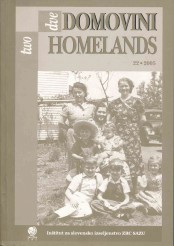ARTISTIC CREATIVITY OF MIGRANTS: THE CASE OF SLOVENES IN ERMANY
Keywords:
migrations, artistic creativity, Slovenians in Gennany, theory of the six Ps, immigration policy, artistsAbstract
The contribution is a study of the connection between two complex phenomena – creativity and migrations; an empiric case for the paper was Slovenes in Germany. So far, mainly psychologists were interested in creativity. Among them, only Jan Makarovič surpassed the narrow frames of the psychological profession and proceeded with creativity from the aspect of anthropology as the most complex science on human, which attempts to comprise the human being in all their manifestations. Creativity is not something mystical, it does not originate from nothing and is not endless; it is not something that descends from human inwardness and that cannot be satisfactory explained. It is about a sum of personal, environmental, sociological and cultural factors that influence the individuals’ capability of creativity. Migrations can be the external stimulating or hindering factors.
We distinguish various forms of creativity; the author excepted artistic creativity and linked it with migrations. The emphasis is on some influences on artistic creativity in the context of the after-war immigration of Slovenes to Germany where from the end of 50s to the beginning of the 70s of the 20th century and in comparison to other European states, the most Slovenes settled. Yet there were few artistic creators among them and later too, few sprung up among that population.
In the centre of migrations and creativity are above all the individual and the environment. The author linked the both phenomena through freedom, cultural contacts, and mental diseases. In the second part of the contribution, the theory of creativity is dealt with in detail, the so-called theory of the six Ps developed by Makarovič. It comprises Opportunities (Prilike) for creativity, the Individual (Posameznik), the Process (Proces), the Product (Produkt), Acknowledgment (Priznanje) and Motion (Premik) or social changes being the consequences of creativity. This theory is partly applied on the concrete migration situation of Slovenes in Germany. Emphasised are the so-called external influences of migrations on creativity, which exhibit in possibilities and incentives a creator receives from the environment. Possibly even more important in this connection is the so-called internal influence of migrations that demonstrates through the individual and their mental qualities and characteristics on which the process of migrations influences as well. As this is only the beginning of the research, many questions remained unanswered, and even more sprung up. In the future, more attention should be devoted to the individual, being a factor or actor in the migration process.
Downloads
References
Becker, Howard S. (1984). A r/ Worlds. London, Los Angeles: The U niversity of California Press, 408 str.
Becker, Howard S. (2005). A New Art Form: Hypertext Fiction (spletni vir: http://hom e. earthlink.net/-hsbecker/lisbon.htm l).
Boyle, Paul, Halfacree, Keith, Robinson, Vaughan (1998). Exp/oring Contemporary Migration. New York: Longman, 282 str.
Brettell, Caroline B., Hollifield, James F. (2000). Introduction. M igration Theory. Talking across Disciplines (uredila Caroline B. Brettell in James F. Hollifield). New York, London: Routledge, str. 1-26.
Castles, Stephen, Miller, M ark J. (1993). The age o f migration. International population movements in the modern world. Basingstoke: Macmillan, 306 str.
Czaplicka, John (1996). Emigrants and Exiles. A lost generation of Austrian Artists in Am erica 1920-1950. Evanston: Northwestern University. 380 str.
Detela, Lev (1999). Francija, Nemčija, Španija, Avstrija. Slovenska izseljenska književnost. 1. zvezek: Evropa, Avstralija, Azija (ur. Janja Žitnik in Helga Glušič). Ljubljana: ZRC, Rokus. 400 str.
Gombač, Jure (2005). Esuli ali optanti? Zgodovinski prim er v luči sodobne teorije. Ljubljana: Založba ZRC.
Klinar, Peter (1976). M ednarodne migracije. Maribor: Obzorja, 306 str.
Klinar, Peter, Toš, Niko, M ežnarič, Silva (1974-1976). Slovenci v ZR Nemčiji. Migracije, bilten. Ljubljana: RSS.
Lukšič - Hacin, Marina (1995). K o tujina postane dom. Ljubljana: Znanstveno in publicistično središče, 214 str.
M akarovič, Jan (2003). Antropologija ustvarjalnosti. Biologija, psihologija, družba. Ljubljana: Nova revija, 350 str.
M ayer, Janez (1991). Ustvarjalno mišljenje in delo. Kranj: M odem a organizacija, 196 str.
M islej, Irene (2002). Slovenski izseljenski likovni umetniki v novem svetu - tri usode. Sem inar slovenskega jezika, literature in kulture (uredila Boža Krakar Vogel) 38, Ljubljana: Center za slovenščino kot drugi tuji jezik, str. 177-186.
Slavec, Ingrid (1982). Slovenci v Mannheimu. Ljubljana: SED, 134 str.
Stare, Franc (1977). Migracije. Organizirane zunanje m igracije Slovencev v obdobju 1965-1975. Ljubljana: FSPN. 119 str.
Thomas, Karin (2002). Kunst in D eutschland seit 1945. Köln: DuM ont, 540 str.
Trstenjak, Anton (1953). Psihologija um etniškega ustvarjanja. Ljubljana: SAZU, 150 str.
Trstenjak, Anton (1981). Psihologija ustvarjalnosti. Ljubljana: Slovenska matica, 535 str.
Zalokar, Jurij (1994). Psychological and Psichopathological Problems o f Im m igrants a n d Refugees. Radovljica: Didakta, 93 str.
Downloads
Published
How to Cite
Issue
Section
License

This work is licensed under a Creative Commons Attribution-NonCommercial-NoDerivatives 4.0 International License.
Authors guarantee that the work is their own original creation and does not infringe any statutory or common-law copyright or any proprietary right of any third party. In case of claims by third parties, authors commit their self to defend the interests of the publisher, and shall cover any potential costs.
More in: Submission chapter





